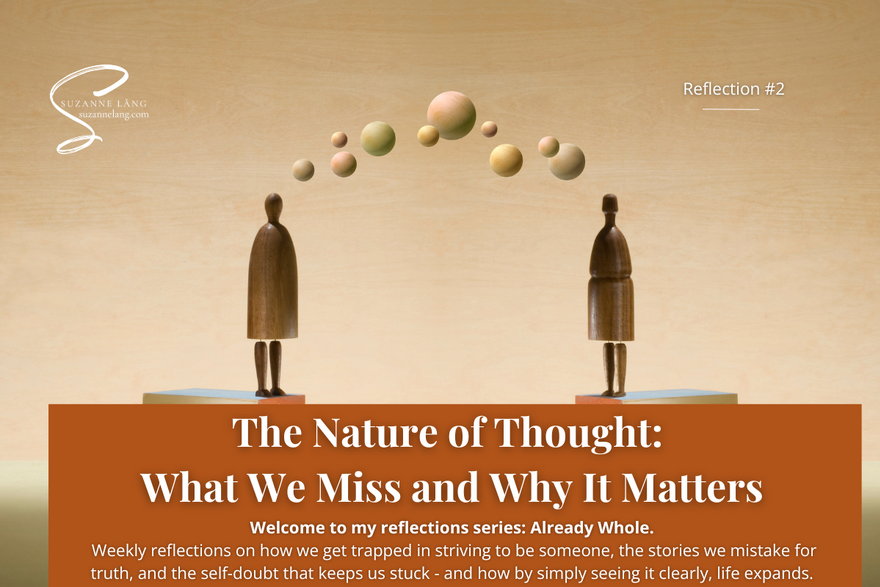
This week, we’re looking at something we often don’t see at all: The Nature of Thought. When we see the true nature of something, we are no longer at the mercy of it. We can respond to it as it is - not as we imagine it to be - and this changes everything. To understand thought, you must experience thought directly. No one can truly teach you about it - not me nor anyone else. You must experience it in your own experience to feel the truth in it.
When we talk about the nature of something, we're pointing to its essence. Its fundamental character. Not what it seems to be, or how it behaves on the surface, but what it is when all interpretation is stripped away.
The nature of water is to flow and take the shape of what holds it.
The nature of a storm is to arise, pass through, and dissolve.
The nature of animals is to be present and respond instinctively.
So what is the nature of thought? How does it behave, what are its properties, what is it before we label it as good or bad, true or false, helpful or harmful?
Is it solid? Can it be touched?
Is it permanent? Can it stay?
Is it reliable? Can it be trusted?
Is it predictable? Can it be controlled?
Is it objective? Can it show reality as it truly is?
When you look closely, you find that a thought is none of those things.
It is not solid - it can’t be held. We can’t put it on the table.
It is not stable - it’s often gone before you even finish noticing it.
It is not personal - it appears without permission, whether kind or mean, judgmental or scared, jealous or joyful.
It is not predictable - it just pops up and comes and goes in ways you cannot foresee or manage.
It is not objective - it is always filtered through millions of different variables in the moment.
So what is it?
If we look in direct experience thought is just momentary flickers - images and sounds appearing in awareness. And they are temporary appearances in awareness – movements in the mind made of words, concepts, images, sensations, or memories arising spontaneously in your experience. Try to think the same thought, and only the same thought for 2 minutes and you will find you can’t. They're subtle forms of energy, like waves that rise and fall within consciousness.
The scientist's answer, grounded in biology and neuroscience says thoughts are the result of electrochemical signals and neural patterns within the brain, generated by billions of neurons communicating through electrical impulses and chemical neurotransmitters.
How can knowing that ever help anyone who is suffering from their thinking? It cannot. Ever.
The scientist tries to explain the biological machinery behind the scenes, but it is your direct experience of thoughts that matter in everyday life. Knowing how the brain produces thoughts will not help us find peace or clarity, whereas seeing through their transient nature can change everything.
Thoughts are always moving. Whispering. Shouting. Suggesting.
They’re the background noise of our lives.
And because they are constant, we seldom pause to ask: what are they, really?
Some we absolutely recognize as thought:
“What should I cook tonight?”
“Remember to call her back.”
“I wonder if this outfit works.”
Those are easy. They come and go like passing clouds, and we know we’re thinking.
But others - especially the ones soaked in emotion - feel different.
They don’t arrive as thoughts.
They arrive as truth.
“I’m not as good as them.”
“They must be disappointed in me.”
“I’m just not good at this.”
“I’m too much. I’m not enough.”
But we don’t notice that we’re thinking.
We just feel small.
Tension-filled. Anxious. Defeated.
It just feels real.
We all assume we’re seeing clearly - when what we’re actually seeing is through lens of conditioning we didn’t even know we were wearing.
This is the most important thing I could ever say to you - and it is without a doubt the hardest thing to even consider, let alone grasp, because 1) we have been taught the exact opposite and 2) to even consider it is terrifying, but:
We do not control our thoughts.
We don’t control which thoughts arrive.
We don’t even invite them in.
They just…appear. One after the other.
They come, they go, they come again and they go again.
But where do they appear?
How do we know what we’re thinking?
Who is noticing the conversation going on in our head?
What is aware of the thoughts?
There is something in which these thoughts arise. It is still. Quiet. Unmoved.
The most wonderful thing of all is that when we see that we are not the thinker, but the awareness in which thinking happens, peace just happens – regardless of how many thoughts are swirling around.
It is the peace of finally letting go of the need to do anything with any thought – just let it be. It is a peace that does not depend on controlling or fixing thoughts, but seeing the space beyond/before them - the silent space in which they appear in - the space that has always been free, untouched, and whole.
Warm regards,
Suzanne 🕊️
To have the direct experience of what I am talking about here I have created an 8 week, 40 day exploration of this called The Space Between Thoughts. Read more here: https://www.suzannelang.com/8weeks


Comments